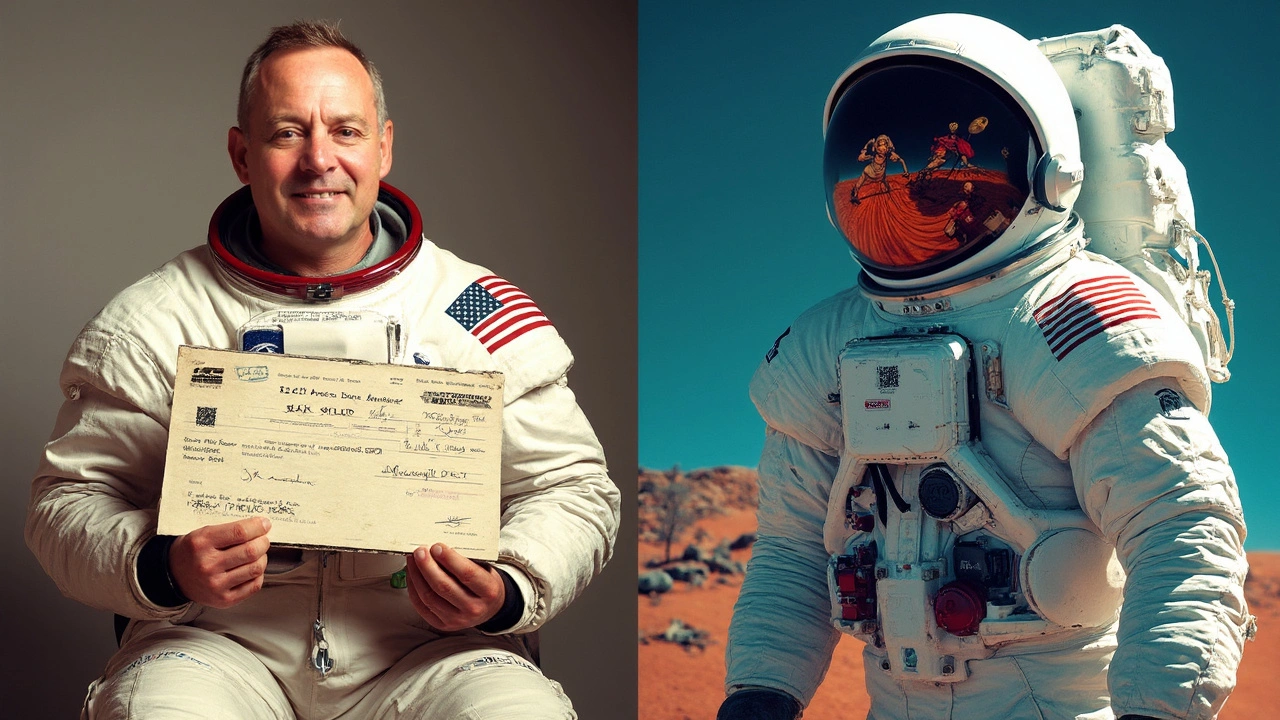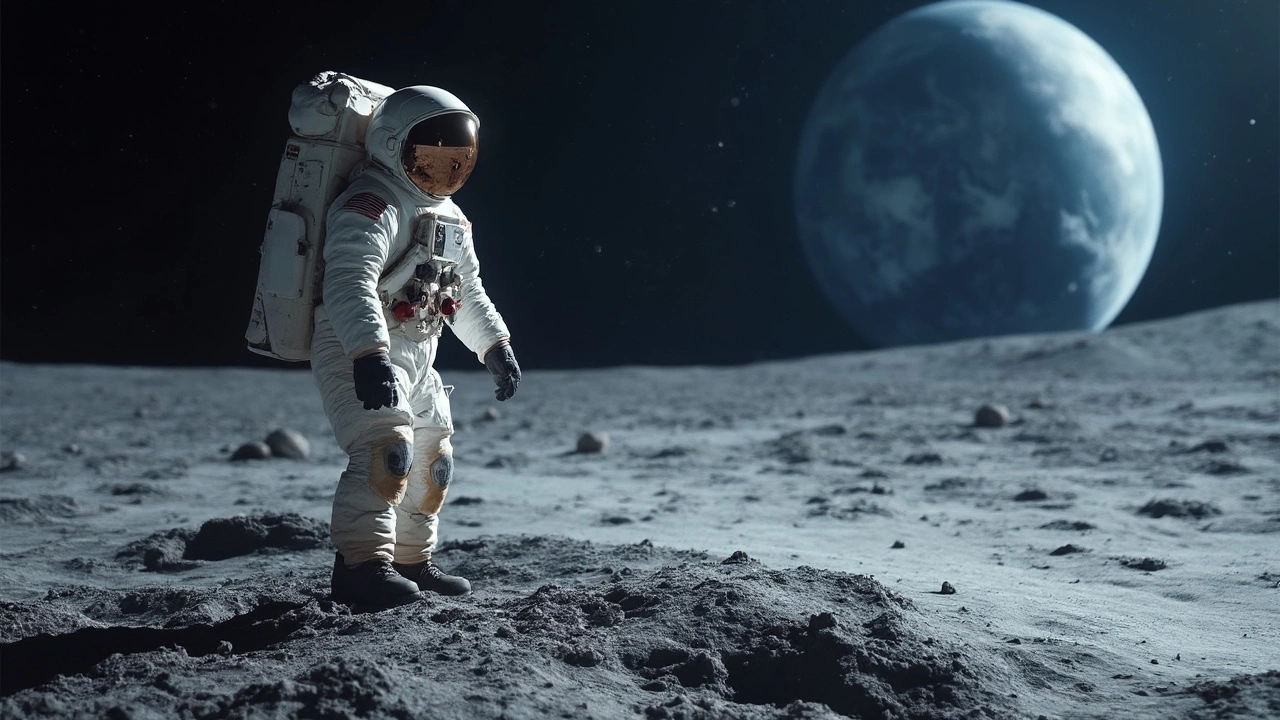We've all heard of Neil Armstrong, the first man to set foot on the Moon, but do you know what he got paid for that legendary step? It might surprise you that his salary was way different than what astronauts take home today. Back in 1969, while he was getting all the glory, his paycheck seemed pretty ordinary by today’s standards.
Neil's annual salary as an astronaut during the Apollo 11 mission was around $30,000. Adjusted for inflation, that's still just under $250,000. Considering the risk and prestige, it's fascinating, right? Sure, it wasn’t about the money, but think about it: Astronauts today earn more than this for just one mission. For Neil, it was all about the mission and making history, not the paycheck.
Compared to his fellow astronauts, Neil wasn't rolling in cash either. But here's the thing—it was never just about the money for these pioneers. The chance to do something no human had done before was the real reward. So what did other astronauts earn, and how does that stack up against current times? We'll get into that next.
- Neil Armstrong's Salary on Apollo 11
- Comparing Astronaut Salaries of the 1960s
- Space Exploration in the Spotlight
- From the Moon to Modern Salaries
- The Value of Exploration Beyond Pay
Neil Armstrong's Salary on Apollo 11
So, just how much did Neil Armstrong earn for his groundbreaking mission as the first human to walk on the Moon? Well, it's not as glamorous as you might think. Neil's annual salary at the time of the Apollo 11 mission in 1969 was about $30,000. In today's money, that would be around $250,000. While it seems like a decent paycheck, considering the risks involved, it doesn't sound like a fortune.
As a NASA astronaut back in the 60s, Neil wasn't earning much more than some senior engineers. And while Neil was the Mission Commander, his salary wasn't even the highest among his peers. In fact, astronauts in managerial roles, like program directors, often took home larger paychecks.
A Day in the Life (and Pay) of an Apollo Astronaut
During those days, the public might have imagined astronauts living like rock stars. In reality, their salaries were linked to the federal government pay scale. Neil, being a civilian test pilot and aeronautical engineer before joining NASA, didn't see a massive jump in earnings moving into space exploration.
Here's a look at the types of earnings for different astronaut roles at the time:
- Entry-level astronauts: Starting at roughly $17,000 annually.
- Mid-tier astronauts: Around $20,000.
- Top-tier astronauts like Neil: Close to $30,000.
Despite the modest paycheck, Armstrong's journey was about more than money—it was about adventure and achieving the impossible. While today's astronauts might earn more, they still share the same spirit as the pioneers of the past.
Comparing Astronaut Salaries of the 1960s
The 1960s was an incredible time for space exploration, with the excitement of reaching the Moon resonating worldwide. But while the achievements of astronauts like Neil Armstrong captivated the world, their paychecks were a bit less glamorous.
Armstrong, piloting the Apollo 11 to the Moon, pocketed around $30,000 a year, as mentioned earlier. What about his co-pilots? Buzz Aldrin, the second man on the Moon, and Michael Collins, who piloted the command module, earned similar salaries. Even the highest-paid astronauts weren't crossing that $30,000 mark by much, after adjustments for inflation.
How Other Jobs Compared
To give you some perspective, the average American salary back then was about $5,000 to $6,000 a year. So, on paper, these astronauts were doing pretty well. But if you consider the unique and extreme dangers involved in space travel, it was more about passion than paychecks.
For a clearer picture, here's a glimpse of astronaut salaries in comparison to other jobs at the time:
| Occupation | Average Yearly Salary (1969) |
|---|---|
| Astronaut (Apollo mission) | $30,000 |
| Business Executive | $15,000 |
| Teacher | $8,000 |
| Factory Worker | $6,000 |
While astronauts did earn more than many professions, their earnings didn't reflect the extraordinary nature of their work.
Pay vs. Passion
The pay differences weren't just a quirk of history. These figures reveal the reality of the times—space exploration was a labor of love. Astronauts risked their lives, not for fat paychecks but for the glory of discovery and the thrill of the unknown.
Today, astronaut salaries have increased significantly, aligning more closely with the immense responsibilities involved. But back in the '60s, for Armstrong and his colleagues, it was all about the mission, not the money.

Space Exploration in the Spotlight
Back in the 1960s, space exploration was front-page news and a source of national pride. Apollo 11, with Neil Armstrong at the helm, didn’t just capture America’s imagination; it captivated the entire world. And get this—the whole mission was watched by about 600 million people on TV! That's nearly one-fifth of the planet's population back then.
The space race wasn’t just about science; it was a massive geopolitical move, a way for the US to show its technological prowess during the Cold War. So when Neil Armstrong took his historic step, it wasn't just a win for NASA, but a symbolic moment for freedom and innovation.
Public Attention and Funding
You might think all the excitement guaranteed endless funding, right? Not quite. While there was enormous public interest in the missions, NASA's budget faced cuts just a few years after the lunar landing. Crazy to think that something so monumental was in danger of losing support, huh?
Here’s a tidbit: In 1966, at the height of the Apollo program, NASA received about 4.5% of the federal budget. Today, it's less than half a percent! That shift illustrates how priorities have evolved, though there’s still a strong push for exploring the cosmos, just with more nuances now.
Name Recognition Worldwide
Thanks to these missions, the names Neil Armstrong and Apollo have become synonymous with courage and exploration. But it wasn't just about the astronauts—thousands of scientists, engineers, and unsung heroes were key players in making those missions a reality.
With attention still on space exploration, especially in places like Australia where new missions are closely followed, it’s clear that what Armstrong and his crew sparked over half a century ago lives on, inspiring new generations to look up at the stars and wonder what's next.
From the Moon to Modern Salaries
So, what's the deal with astronaut salaries these days compared to Neil Armstrong's time? Spoiler: it's a whole different ball game. Back during the Apollo era, space explorers got respectable pay for their massive contributions to science and humanity. But today's astronauts, with increasingly high-stakes missions and a heightened public profile, see better paychecks.
Modern astronaut salaries vary based on experience and agency. NASA astronauts, for instance, have salaries that range from about $66,000 to over $144,000 annually. Doesn't sound too shabby, right? While it's not tech billionaire money, for many astronauts it's the experience and dream of space travel that counts the most.
Besides basic salary, let's not forget the bonuses and allowances these heroes might get. Factors like mission length and hands-on time in space can mean additional funds. However, the financial landscape isn't just different thanks to inflation and tiered pay scales—there's more to the story.
The International Perspective
Looking beyond NASA, astronauts from other countries experience diverse financial perks. European astronauts, courtesy of the European Space Agency, earn around $74,000 to $85,000, a sum adjusted by taxes and fees, while Russian cosmonauts start at a lower rate but gain valuable experience and prestige.
Curious how this all stacks up globally? Check out this comparison of astronaut pay:
| Agency | Approximate Salary Range (USD) |
|---|---|
| NASA | $66,000 - $144,000 |
| ESA | $74,000 - $85,000 |
| Roscosmos | ~$30,000+ |
The takeaway? While Armstrong's earnings were groundbreaking then, astronaut pay has evolved with new demands and expectations. Even though it’s still not about raking in cash, today's astronauts enjoy a more comfortable living, reflecting the ever-increasing value placed on space exploration and its contributions to our world.

The Value of Exploration Beyond Pay
When you think about Neil Armstrong's journey, it wasn't just about a paycheck, even if the $30,000 salary was a decent number for the 1960s astronaut standard. These missions were about something much larger—pushing the boundaries of human knowledge and curiosity. Imagine being one of the first to walk on the Moon—that's an experience no amount of money can buy.
Astronauts, like Armstrong, were driven by the chance to achieve the impossible, to go where no one had gone before. This spirit of adventure and discovery is priceless and has fueled space exploration since the beginning. Exploring space isn't just about expanding our knowledge and capabilities. It's about inspiring generations to look up and wonder: 'What else is out there?'
Space's Ripple Effect
The value of these missions goes beyond personal dreams. They've led to technological advancements that we use in everyday life. We're talking about things like memory foam, satellite TV, and even some medical imaging technologies. So, while the Apollo 11 mission wasn't raking in the big bucks for Armstrong or his crew, the benefits to society were, and still are, vast.
Also, exploring space has strengthened international relations and collaboration, with numerous countries joining the mission to understand the universe. Think of the International Space Station as a floating United Nations, fostering teamwork that transcends borders.
The Intrinsic Worth of Space Exploration
Beyond the tangible benefits, there's a sense of purpose and achievement. Those who venture into space aren't just astronauts; they're representing humanity. Their journeys remind us of the incredible things people can achieve when they step out of their comfort zones.
Seeing the Earth from space gives astronauts a unique perspective, often leading to what some describe as the "overview effect," a profound realization of Earth's fragility and the need to protect our planet. It's experiences like these that highlight the enduring value of space exploration, far beyond any paycheck.

